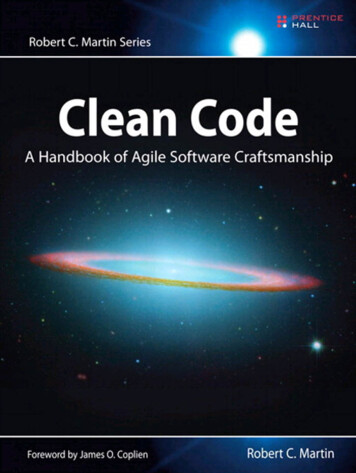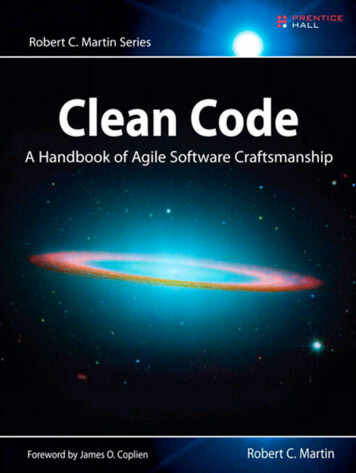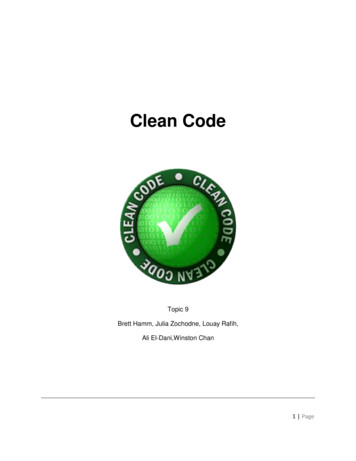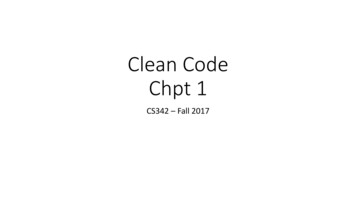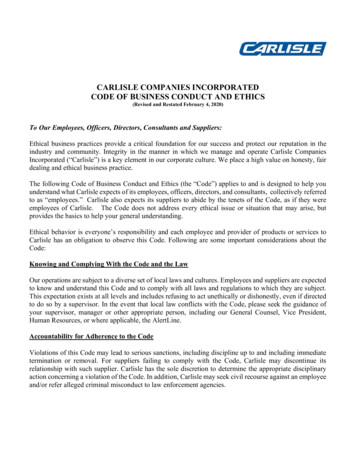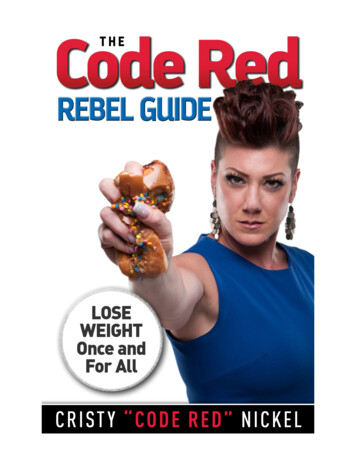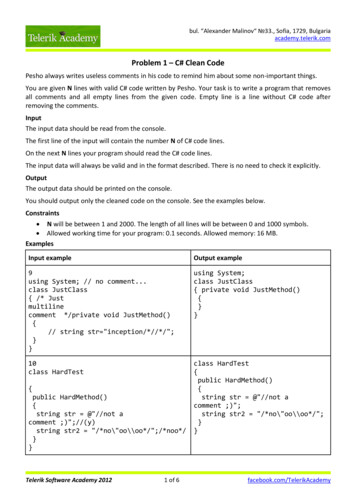
Transcription
bul. “Alexander Malinov“ 33., Sofia, 1729, Bulgariaacademy.telerik.comProblem 1 – C# Clean CodePesho always writes useless comments in his code to remind him about some non-important things.You are given N lines with valid C# code written by Pesho. Your task is to write a program that removesall comments and all empty lines from the given code. Empty line is a line without C# code afterremoving the comments.InputThe input data should be read from the console.The first line of the input will contain the number N of C# code lines.On the next N lines your program should read the C# code lines.The input data will always be valid and in the format described. There is no need to check it explicitly.OutputThe output data should be printed on the console.You should output only the cleaned code on the console. See the examples below.Constraints N will be between 1 and 2000. The length of all lines will be between 0 and 1000 symbols. Allowed working time for your program: 0.1 seconds. Allowed memory: 16 MB.ExamplesInput exampleOutput example9using System; // no comment.class JustClass{ /* Justmultilinecomment */private void JustMethod(){// string str "inception/*//*/";}}using System;class JustClass{ private void JustMethod(){}}10class HardTestclass HardTest{public HardMethod(){string str @"//not acomment ;)";string str2 "/*no\"oo\\oo*/";}}{public HardMethod(){string str @"//not acomment ;)";//(y)string str2 "/*no\"oo\\oo*/";/*noo*/}}Telerik Software Academy 20121 of 6facebook.com/TelerikAcademy
bul. “Alexander Malinov“ 33., Sofia, 1729, Bulgariaacademy.telerik.comProblem 2 – SudokuSudoku is a logic-based, combinatorial number-placement puzzle. The objective is to fill a 9 9 grid withdigits so that each column, each row, and each of the nine 3 3 sub-grids that compose the grid containall of the digits from 1 to 9.On the pictures bellow you can see a Sudoku puzzle and its solution:You are given a partially completed grid, which always has a unique solution. Your task is to solve thegiven Sudoku puzzle.InputThe input data should be read from the console.You will be given 9 lines with 9 symbols with numbers and dashes. The dashes represent empty cells.The input data will always be valid and in the format described. There is no need to check it explicitly.OutputThe output data should be printed on the console.You should print the solved Sudoku puzzle. See the examples bellow.Constraints Allowed working time for your program: 0.2 seconds. Allowed memory: 16 MB.ExamplesInput ---2---6-6----28---419--5----8--79Output 91713924856961537284287419635345286179Telerik Software Academy 2012Input 3-------263--5-5-37----847---1---2 of 6Output /TelerikAcademy
bul. “Alexander Malinov“ 33., Sofia, 1729, Bulgariaacademy.telerik.comProblem 3 – EmployeesMitko is the boss of a big software company called "MCPF" (Mitko Can't Play Football). MCPF has Memployees with N different positions. Each position has a rating (number indicating how important theposition is in the company's hierarchy). This rating will be positive integer number between 0 and10000, inclusive.Your task is to write a program that orders Mitko's employees by their position. If two employees'positions are equally rated, then your program should order them lexicographically by their last (family)name. And if two employees have equally rated positions and same family names, your program mustalso sort them by their first name lexicographically.InputThe input data should be read from the console.On the first line there will be the number N – the total number of positions in MCPF. On each of the nextN lines there will be one job title and its rating, separated by dash ("-"). See the example below.On the very next line there will be the number M – the total number of employees in MCPF. On each ofthe next M lines there you will find one employee’s name (first name and last name separated by singlespace) and the employee's position. The employee's name and his position will be separated by dash (""). See the example below.The input data will always be valid and in the format described. There is no need to check it explicitly.OutputThe output data should be printed on the console.Your program must print exactly M lines, containing the employee's names, ordered by the rulesexplained above. Each name must be shown on a single line.Constraints N will be between 1 and 1000, inclusive. M will be between 1 and 1000, inclusive. The length of all position names, first and last names will be between 1 and 100, inclusive. Allowed working time for your program: 0.1 seconds. Allowed memory: 16 MB.ExampleInput exampleOutput example9Trainee - 0Owner - 100CEO - 98Junior Developer - 30Unit Manager - 95Project Manager - 95Team Leader - 94Dimitar DimitrovBlagoy MakendzhievMichel PlatiniPetar AtanasovAdemar JuniorIvan BandalovskiApostol PopovAtanas GeorgievTelerik Software Academy 20123 of 6facebook.com/TelerikAcademy
bul. “Alexander Malinov“ 33., Sofia, 1729, Bulgariaacademy.telerik.comSenior Developer - 50Developer - 4010Georgi Georgiev – TraineeAdemar Júnior – Unit ManagerDimitar Dimitrov – OwnerPetar Atanasov – Project ManagerAtanas Georgiev – TraineeJúnior Moraes – TraineeIvan Bandalovski – DeveloperApostol Popov – DeveloperMichel Platini – CEOBlagoy Makendzhiev - CEOGeorgi GeorgievJunior MoraesProblem 4 – 3D Max WalkYou are given a rectangular cuboid of size W (width), H (height) and D (depth) consisting of W * H * Dcubes, each containing an integer number. A 3D max walk in the cuboid starts from the cube located atthe cuboid's center (W, H and D are odd numbers). At each step the walk continues from the currentcube in one of the 6 possible directions (left, right, up, down, deeper, shallower) to the cube which holdsthe maximal value among all possible cubes different than the current. The walk stops at some of thefollowing conditions: Several cubes hold the same maximal value. There is only cube holding the maximal value but it is already visited (falls into a loop).Your task is to write a program that finds the sum of the numbers in the cubes that are visited duringthe 3D max walk.InputThe input data should be read from the console. At the first line 3 integers W, H and D are givenseparated by a space. These numbers specify the width, height and depth of the cuboid. At the next Hlines the colors of the cubes in the cuboid are given as D sequences of exactly W integers. Each of thesesequences consists of W integers separated by a single space. The sequences of W integers areseparated one from another by " " (space vertical line space).The input data will be correct and there is no need to check it explicitly.OutputThe output data should be printed on the console.At the first line of the output print the sum of the cubes visited by the 3D max walk.Constraints The numbers W, H and D are odd integers in the range [1 101].The integers in the cuboid are in the range [-1000 1000]Allowed work time for your program: 0.3 seconds.Allowed memory: 16 MB.Telerik Software Academy 20124 of 6facebook.com/TelerikAcademy
bul. “Alexander Malinov“ 33., Sofia, 1729, tOutput532134315819347831 9 1 0 1 2 3 8 1 2 5 6 73 1 9 2 5 5 2 1 8 6 3 5 82 1 5 9 1 3 8 6 4 5 6 3 232641345At the first example the visited cubes are: 5 - 5 - 7 - 9 - 8. After 8 the maximal possible number is 9,which is already visited (falls into a loop). At the second example the visited cubes are 6 - 5 - 8. After 8there are two maximal numbers (value 5) so the walk stops.Problem 5 – LiquidYou are given a rectangular cuboid of size W (width), H (height) and D (depth) consisting of W * H * Dcubes, each containing an integer number specifying its capacity – how much liquids can pass throughthe cube per fixed unit of time (a non-negative integer number). Two cubes are neighbors if they sharethe same side. There are holes with unlimited capacity at the top side of all cubes staying at the top sideof the cuboid. There are also holes with unlimited capacity at the bottom side of all cubes staying at thebottom side of the cuboid.Suppose we have an unlimited supply of liquid spilled at the top of the cuboid and that the liquid canpass freely from one cube to all its neighbors except the cube above it. Your task is to write a programwhich calculates the amount of liquid that could pass from the top side of the cuboid through the topholes through its cubes to the bottom side of the cuboid and then outside of it through the bottomholes.InputThe input data should be read from the console. At the first line 3 integers W, H and D are givenseparated by a space. These numbers specify the width, height and depth of the cuboid. At the next Hlines the colors of the cubes in the cuboid are given as D sequences of exactly W integers. Each of thesesequences consists of W integers separated by a single space. The sequences of W integers areseparated one from another by " " (space vertical line space).The input data will be correct and there is no need to check it explicitly.OutputThe output data should be printed on the console.At the first line of the output print the amount of liquid that can passfrom the cuboid's top side to the cuboid's bottom side.Constraints The numbers W, H and D are integers in the range [1 15].The integers in the cuboid are in the range [0 100]Allowed work time for your program: 0.5 seconds.Allowed memory: 64 MB.Telerik Software Academy 20125 of 6facebook.com/TelerikAcademy
bul. “Alexander Malinov“ 33., Sofia, 1729, tOutput4 2 33 0 9 0 4 2 1 2 0 0 5 10 8 0 0 0 2 2 0 0 1 1 033 2 11 2 34 5 621The flow of the liquids for first of the above examples is shown on the figure above.Telerik Software Academy 20126 of 6facebook.com/TelerikAcademy
Problem 1 – C# Clean Code Pesho always writes useless comments in his code to remind him about some non-important things. You are given N lines with valid C# code written by Pesho. Your task is to write a program that removes all comments and all empty lines from the given code. Em


